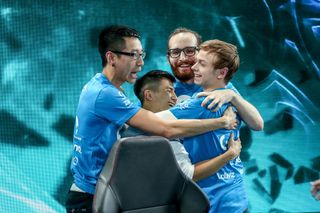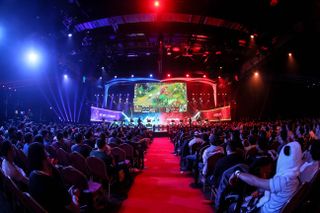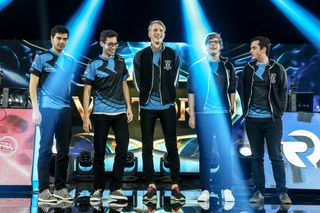Worlds turns the League of Legends scene on its head

We're only just past the first week of the League of Legends 2015 World Championship, and it's hard to believe what's happened so far. For the last two years, the narrative was straightforward: the spotlight was all on the Korean and Chinese teams to demonstrate how the game should really be played, while the western LCS sideshows tussled with the wild card teams for fan appeasement sets.
And this year? Oh, boy, this year. Hard to decide where to begin. In four days, most of our assumptions about relative regional strength has been tossed out the window. Everybody's attempts at picking the group results have been left in shambles as formerly-strong teams and regions fall short of their reputations and the true powers step out of the shadows of obscurity. Some of the teams currently facing the ignoble prospect of group stage elimination were expected to win the tournament and title outright—begging the question as to what happened since the Mid-Season Invitational, which largely stuck to the script.
The first lesson learned: Aphromoo was right.
Not for sale
Money can buy a lot of things. When you count a few million as pocket change thanks to dynasties that have benefited significantly from the nation's economic investments, it can buy you a lot of neat and useful things in esports. Huge and fancy gaming houses, high-quality uniforms, legions of analysts to crunch the numbers for you... even loyalty.
Money can buy talent, coaches, individual players. It can't seem to buy China an actual team.
I interviewed Counter Logic Gaming support player Zaqueri 'Aphromoo' Black just over a week ago, and it was his claim that the Chinese teams were overrated despite a successful victory over legendary 2013 world champion team SKT T1 back during the MSI. The core of his claim was communications issues—Korean and Mandarin are not mutually intelligible languages, and while codified phrases can help bridge the gap (as well as plain old game sense and lots of practice together), it can only go so far for them. Nuanced shotcalling will be lost: tactical inflexibility might not be a huge detriment against fellow LPL teams, as they've played them dozens of times and know their strengths and weaknesses inside and out, but it proved to be absolutely lethal on the international level.
The biggest gaming news, reviews and hardware deals
Keep up to date with the most important stories and the best deals, as picked by the PC Gamer team.
It's not as if the players are bad. China got what they paid for: the Korean players have mechanics, have lane pressure, and can win a straight-up one-on-one. Too bad that the 2015 meta, and the overall design direction for Patch 5.18, severely limits how much a single player's contribution is worth in terms of overall victory. Even the much-lamented Juggernaut reworks have been thoroughly exposed: sure, Darius and Fiora are deadly adversaries if they can get up close and personal. 'If'. Most of the time, they'll be slowed by Gnar's boomerang, bedazzled by Lulu's Glitterlance, outright knocked away by Azir's Emperor's Divide... a crafty player (and one conservative in their Flash expenditures) can work around these obstacles, but only with a team to further support them and make those opportunities possible.
That requires on-the-fly tactical play, and that's exactly why China's first seed, LGD Gaming, is doing even worse than both of their Taiwanese counterparts. It's why Invictus Gaming was made to look miserable by both Cloud 9 and Fnatic. And why, on Patch 5.18, Edward Gaming can no longer handle Korea's SKT T1.

Heads held Hai
Not to say that Korea's safe. Just as Edward Gaming is the only Chinese team with a positive win rate so far, so is SKT T1 the only Korean team not actively worrying about their group stage performance. China's 2014 post-season ploy was to strengthen themselves by defanging South Korea—and while they largely failed the first half of that mission, the second half was undeniably successful. The traditional fear that accompanies a matchup against a KeSPA team is notably missing this year, and it's demonstrated not only in results but gameplay as well, with all teams much more willing to engage aggressively and making gambits that they would've shied away from in previous encounters.
Granted, all that still makes South Korea a powerhouse region. KOO Tigers' loss to Flash Wolves and KT Rolster's defeat in the hands of EU LCS's Origen were unexpected, but they still come out of Week One with a 2-1 lead. So far, all three Korean teams are on track to make it out of the group stages, therefore giving KeSPA the best odds of all regions to once again claim the world championship title. But while statistics and results might say one thing, their actual in-game performance is not nearly as confident or as crushing as it was in the last two years—especially versus the western representatives.
Has it finally happened? Has the west caught up? To the shock of all in attendance, Cloud 9—ranked 7th in North America after a disastrous summer split—ends their first Worlds week undefeated by the likes of Invictus Gaming, ahq E-Sports Club and Fnatic. Team captain Hai Lam may go down in esports history as League of Legend's number one most successful player-leader, demonstrating not only jungle mechanics in excess of what was expected of the former (and ailing) mid laner, but also well above the mark for a player that was planning to retire. There is all the chance in the world (and many more chances than initially expected) that he comes out of this as a messianic figure for North American LoL, recovering three proverbial days after a career-ending death from a collapsed chest, ruined wrists and declared retirement to lift his team and region to the Olympian heights of the playoff brackets.
And this after slaughtering the North American regionals in back-to-back reverse-sweep upsets. What a man. What a player. What a leader.

Meanwhile, the figureheads for EU LCS are pretty familiar, if even more successful. xPeke's world championship buff is now a thing of legend, and demand is white-hot for a baguette-wielding Fiora skin to honor top laner and France's native son sOAZ's contribution to Origen's 3-0 lead over both LGD Gaming and KT Rolster, the #1 and #3 seeds of China and Korea, respectively. In fact, the overall performance of EU mid laners—both on EU and NA LCS rosters, thanks to Bjergsen and Incarnati0n—have been markedly impressive, with the region producing this year's mechanically scariest players not named Faker. In Bjergsen's case, excepting a relieving victory over LGD Gaming, he's also the only player on his team to be doing well.
Something strange is definitely in the air. It's as if being on Old World soil is giving the west a significant stats boost in and out of game. A diet of French cuisine and blisteringly angry EU West solo queue has had a transformative effect on regions that thought they were going to be second-tiers against the eastern hemisphere for however long League of Legends lasts as an esport. In truth, of course, it's the result of hard, laborious investments—the culmination of two year's determined development of infrastructure, coaching practices, analytical support and player development to produce equals or near-equals worthy of challenging the eastern tyranny. And this month, we get to witness the harvest.
Against Faker, you need miracle-makers. And it might be appropriate, indeed, for a western miracle to be borne on western soil.

PC Gamer Pro is dedicated to esports and competitive gaming. Check back every day for exciting, fun and informative articles about League of Legends, Dota 2, Hearthstone, CS:GO and more. GL HF!
Most Popular




